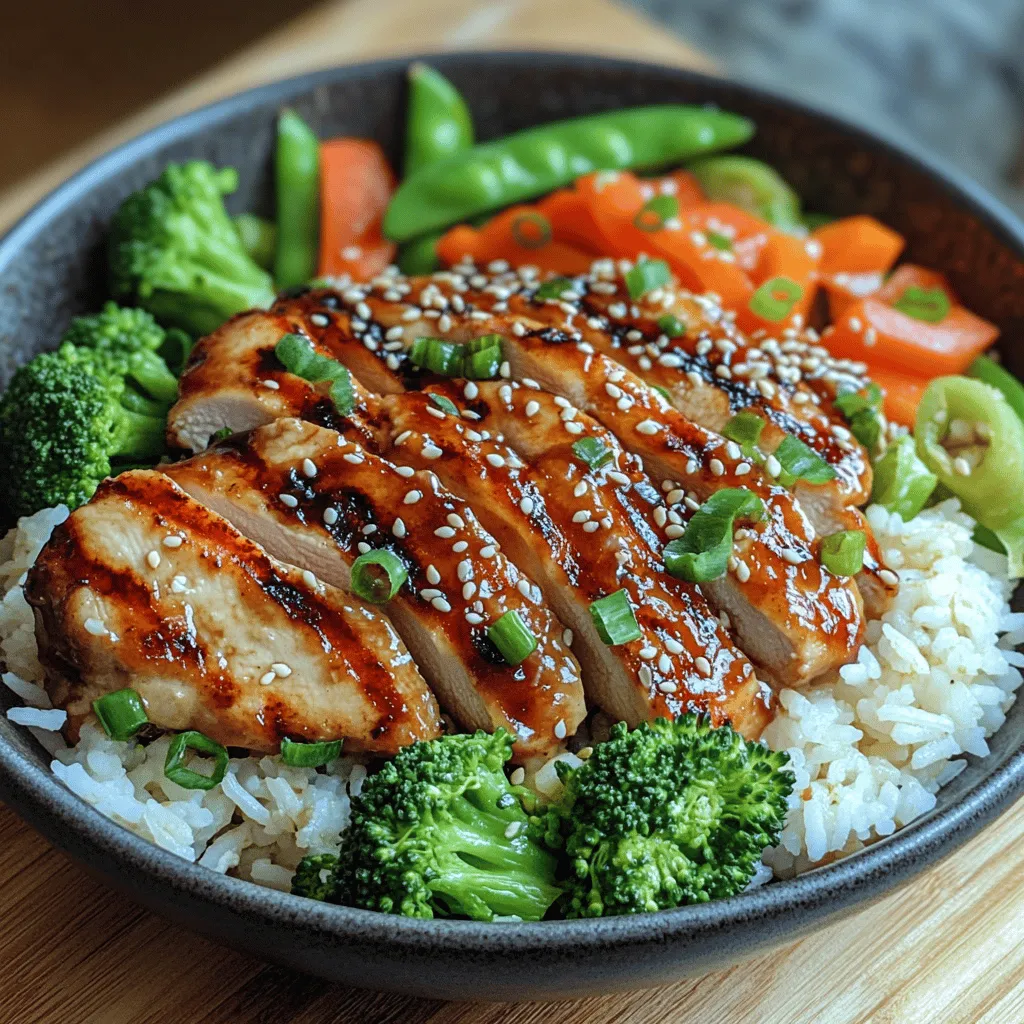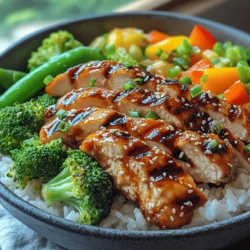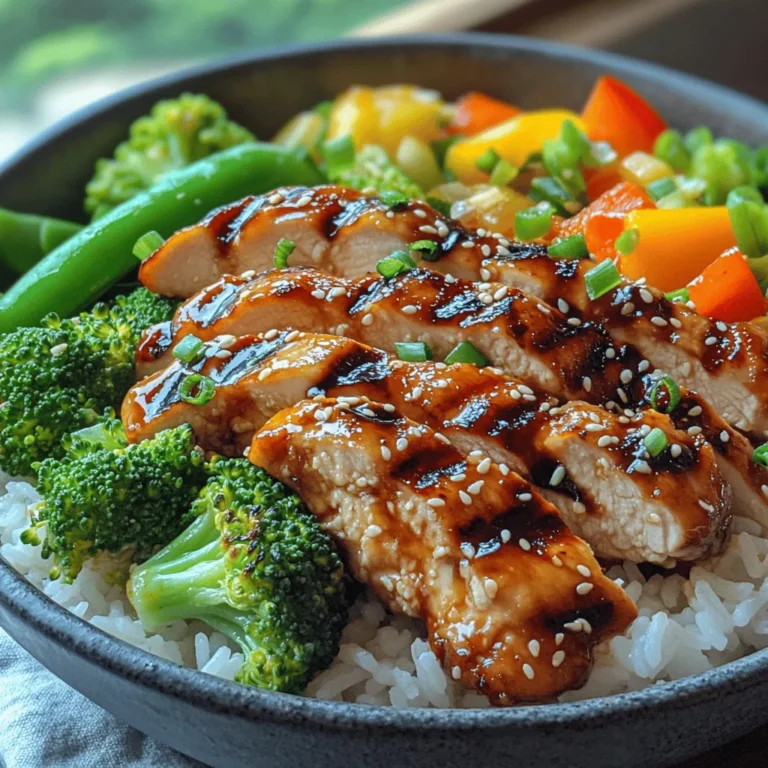The Teriyaki Chicken Bowl is a delightful dish that has gained immense popularity for its balance of flavors and nutritional components. This recipe is not only bursting with savory goodness but also offers a healthy eating option that’s easy to prepare. Combining tender chicken, colorful vegetables, and a rich teriyaki sauce, this bowl provides an excellent source of protein, vitamins, and carbohydrates, making it a well-rounded meal for any occasion.
Ingredients
– 1 lb boneless, skinless chicken thighs or breasts
– 1/4 cup low-sodium soy sauce
– 2 tablespoons mirin
– 2 tablespoons honey or maple syrup
– 1 tablespoon fresh ginger, minced
– 2 cloves garlic, minced
– 2 cups broccoli florets
– 1 red bell pepper, sliced
– 1 cup snap peas
– 1 large carrot, julienned
– 2 tablespoons sesame oil (or olive oil)
– Cooked rice or quinoa for serving
– Sesame seeds for garnish (optional)
– Green onions, chopped for garnish (optional)
Instructions
1. Prepare the Marinade: In a medium bowl, whisk together the low-sodium soy sauce, mirin, honey or maple syrup, minced ginger, and minced garlic until well combined.
2. Marinate the Chicken: Place the chicken in a resealable plastic bag or shallow dish. Pour the marinade over the chicken, ensuring it’s fully coated. Seal the bag or cover the dish and refrigerate for at least 30 minutes, or up to 2 hours for maximum flavor.
3. Cook the Chicken: Heat 1 tablespoon of sesame oil in a large skillet or wok over medium-high heat. Remove the chicken from the marinade (reserve the marinade for later use) and add it to the skillet. Cook for about 6-7 minutes per side, or until the chicken is cooked through and golden brown. Remove the chicken from the skillet and let it rest for a few minutes before slicing.
4. Stir-Fry the Vegetables: In the same skillet, add the remaining tablespoon of sesame oil. Add the broccoli, bell pepper, snap peas, and carrot. Stir-fry for about 4-5 minutes, or until the vegetables are tender-crisp.
5. Combine and Serve: Slice the cooked chicken and return it to the skillet with the vegetables. Pour the reserved marinade over the chicken and vegetable mixture, stirring to combine. Cook for an additional 2-3 minutes until everything is heated through.
6. Assemble the Bowl: Serve the teriyaki chicken and vegetables over a bed of cooked rice or quinoa. Garnish with sesame seeds and chopped green onions if desired.
Understanding Teriyaki Sauce
Teriyaki sauce is a cornerstone of Japanese cuisine, known for its sweet and savory flavor profile. The name “teriyaki” refers to a cooking technique that involves grilling or broiling food while basting it with a glaze made primarily from soy sauce, mirin, and sugar. This results in a shiny, caramelized exterior that enhances the dish’s visual appeal and taste.
The key ingredients of teriyaki sauce include:
– Soy Sauce: Provides the salty umami flavor that forms the backbone of the sauce.
– Mirin: A sweet rice wine that adds depth and complexity to the flavor.
– Sweeteners: Honey or maple syrup contribute natural sweetness, balancing the savory notes of soy sauce.
Teriyaki sauce is incredibly versatile, making it not just ideal for chicken but also suitable for beef, fish, tofu, and an array of vegetables. This adaptability allows cooks to experiment with different proteins and create a variety of teriyaki-inspired dishes.
Ingredients Breakdown
For this teriyaki chicken bowl, selecting quality ingredients is essential for achieving the best flavor and nutritional value.
– Chicken: Using boneless, skinless chicken thighs or breasts ensures tenderness and quick cooking. Thighs tend to be juicier, while breasts are leaner.
– Low-Sodium Soy Sauce: Opting for low-sodium soy sauce reduces the overall sodium content of the dish, making it a healthier choice without sacrificing flavor.
– Mirin: This ingredient enhances the umami depth of the dish, and its slight sweetness complements the other flavors.
– Honey or Maple Syrup: These natural sweeteners not only add flavor but also offer health benefits over refined sugars.
– Fresh Ginger and Garlic: Both ingredients act as flavor boosters and bring their own health properties, including anti-inflammatory benefits.
The vegetables included in this recipe—broccoli, bell peppers, snap peas, and carrots—not only add vibrant colors but also provide a range of nutrients. For instance, broccoli is rich in vitamin C, while bell peppers offer a good source of antioxidants.
When it comes to cooking oil, sesame oil is a fantastic choice for its rich flavor, whereas olive oil can be used for a lighter option during the vegetable stir-fry.
This detailed breakdown of ingredients not only helps in understanding their importance in the dish but also emphasizes the health-conscious choices that can be made while preparing this delightful Teriyaki Chicken Bowl.

Tips for Achieving Perfect Grilling or Pan-Searing for Chicken
When preparing teriyaki chicken, the cooking method significantly impacts the flavor and texture of the chicken. Here are some essential tips to ensure you achieve a perfectly cooked chicken:
Choose the Right Cut of Chicken
Opt for boneless, skinless chicken thighs or breasts. Thighs are often juicier and more forgiving during cooking, while breasts can be leaner but may dry out if overcooked.
Marinade Properly
Marinate the chicken for at least 30 minutes, but ideally for a couple of hours. This allows the flavors to penetrate the meat, enhancing its taste.
Preheat Your Grill or Pan
Make sure your grill or skillet is preheated to medium-high heat. A hot surface helps achieve a nice sear and prevents the chicken from sticking.
Avoid Overcrowding
When cooking, ensure there is enough space for each piece of chicken. Overcrowding can lead to steaming rather than searing, resulting in a less flavorful dish.
Making the Sauce
Creating a homemade teriyaki sauce is simple and rewarding. The key to a great sauce lies in using the reserved marinade and thickening it properly.
Importance of Using Reserved Marinade
After marinating the chicken, set aside a portion of the marinade before adding the chicken. This reserved marinade can be cooked down to create a rich sauce that complements the chicken beautifully.
Thickening Process
To thicken the sauce, simmer the reserved marinade in a saucepan until it reduces and reaches a desired consistency. This process intensifies the flavors while ensuring safety, as the sauce has been boiled.
Steaming Vegetables
Steaming vegetables is an excellent method for maintaining their nutritional value.
Benefits of Steaming
Steaming helps retain more vitamins and minerals compared to boiling, where nutrients can leach into the water. It also preserves the vibrant colors and textures of the vegetables, making your bowl more appealing.
Assembling the Bowls
The final step is to assemble your teriyaki chicken bowls beautifully.
Layering Technique
Start with a base of rice or quinoa, then add the grilled chicken. Follow with a generous serving of steamed vegetables. Drizzle the thickened teriyaki sauce on top and finish with your choice of toppings. This layering technique not only enhances presentation but also creates a balance of flavors in each bite.
Nutritional Benefits of the Teriyaki Chicken Bowl
This dish is not just delicious; it’s also packed with nutritional benefits.
Macronutrient Breakdown
A typical teriyaki chicken bowl offers a balanced blend of protein from the chicken, carbohydrates from the rice, and healthy fats if you include toppings like avocado.
Vitamins and Minerals
The vegetables add a wealth of vitamins and minerals, including vitamin A, vitamin C, and various B vitamins, contributing to your daily nutritional needs.
Health Benefits of Homemade Sauce
By making your own teriyaki sauce, you control the ingredients, reducing added sugars and preservatives often found in store-bought versions. This choice promotes a healthier meal overall.
Serving Suggestions and Variations
To cater to different dietary preferences, consider the following alternatives and enhancements:
Alternative Proteins
For a vegetarian option, try using tofu or tempeh. Shrimp or beef can also be delicious substitutes for those who prefer seafood or red meat.
Additional Toppings
Enhance your dish with toppings such as sliced avocado, pickled ginger, or edamame. These additions not only boost flavor but also increase the nutritional profile.
Customizing Spice Levels
For spice lovers, consider adding chili flakes or a drizzle of sriracha to elevate the heat and add an extra layer of flavor.
Cultural Significance of Teriyaki Dishes
Teriyaki has deep roots in Japanese culture, originally used as a cooking technique that involves grilling or broiling food with a glaze. Over time, it has evolved into a global favorite, adapted in various cuisines around the world. This versatility showcases the dish’s ability to resonate with diverse palates.
Conclusion
The Teriyaki Chicken Bowl is a delicious and versatile meal option that can be enjoyed by everyone. It’s an excellent way to experience the joy of cooking while sharing delightful flavors with loved ones. Encourage yourself to experiment with different ingredients and techniques, and relish the process of creating a wholesome meal from scratch.


